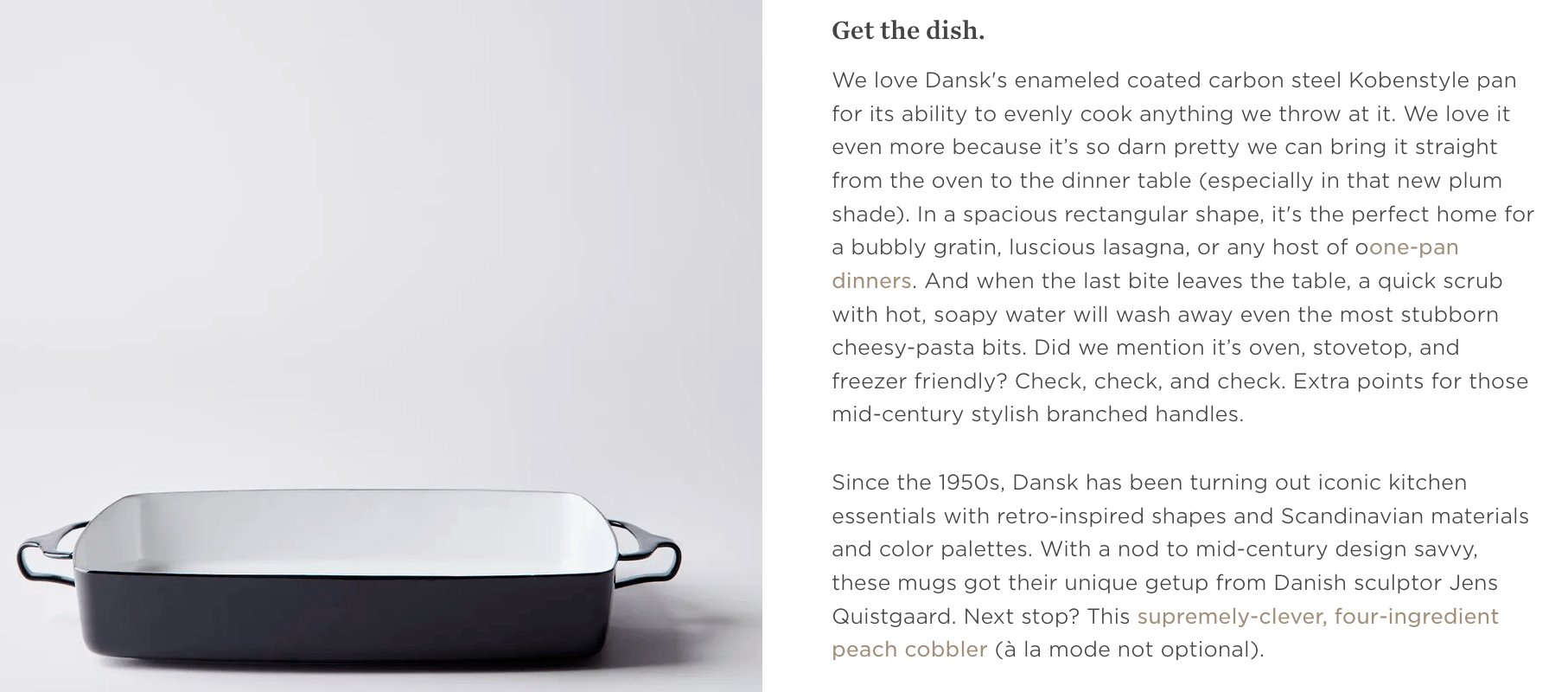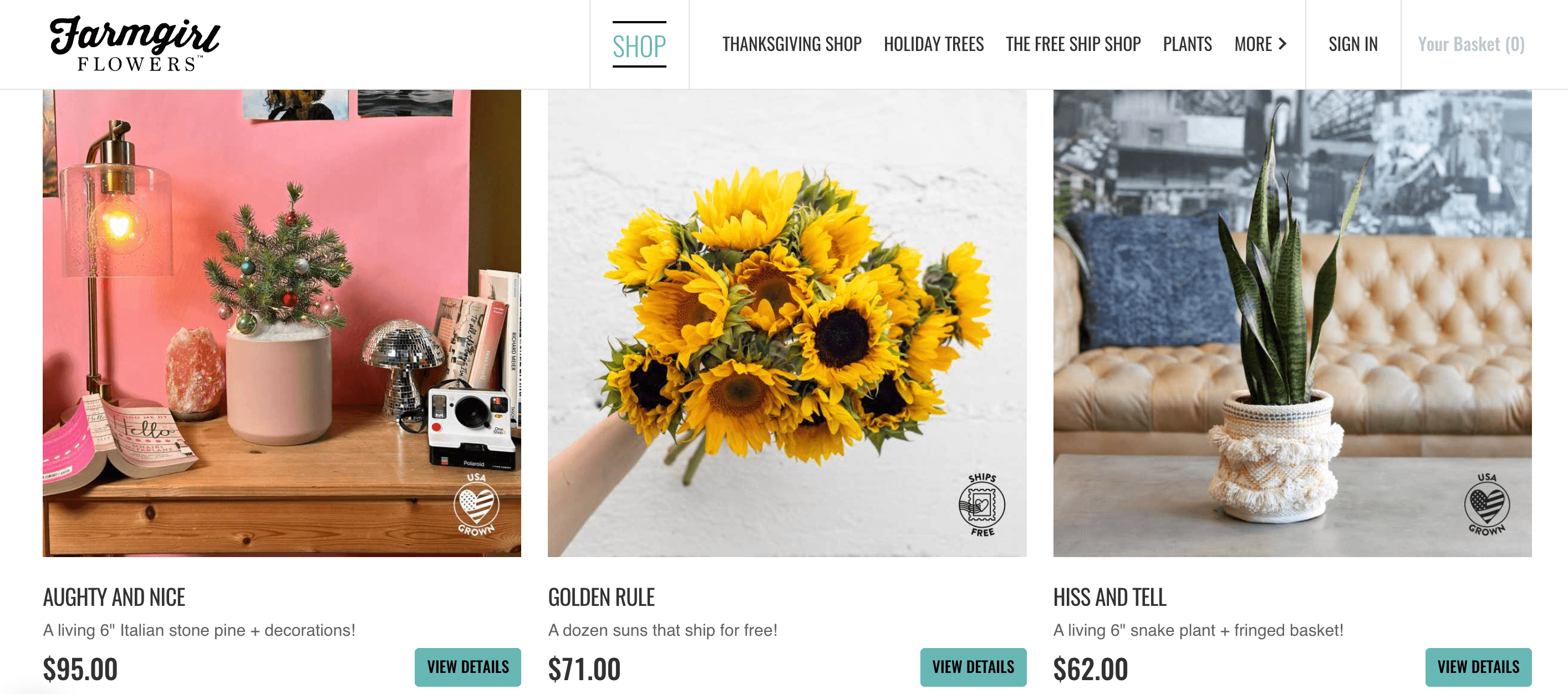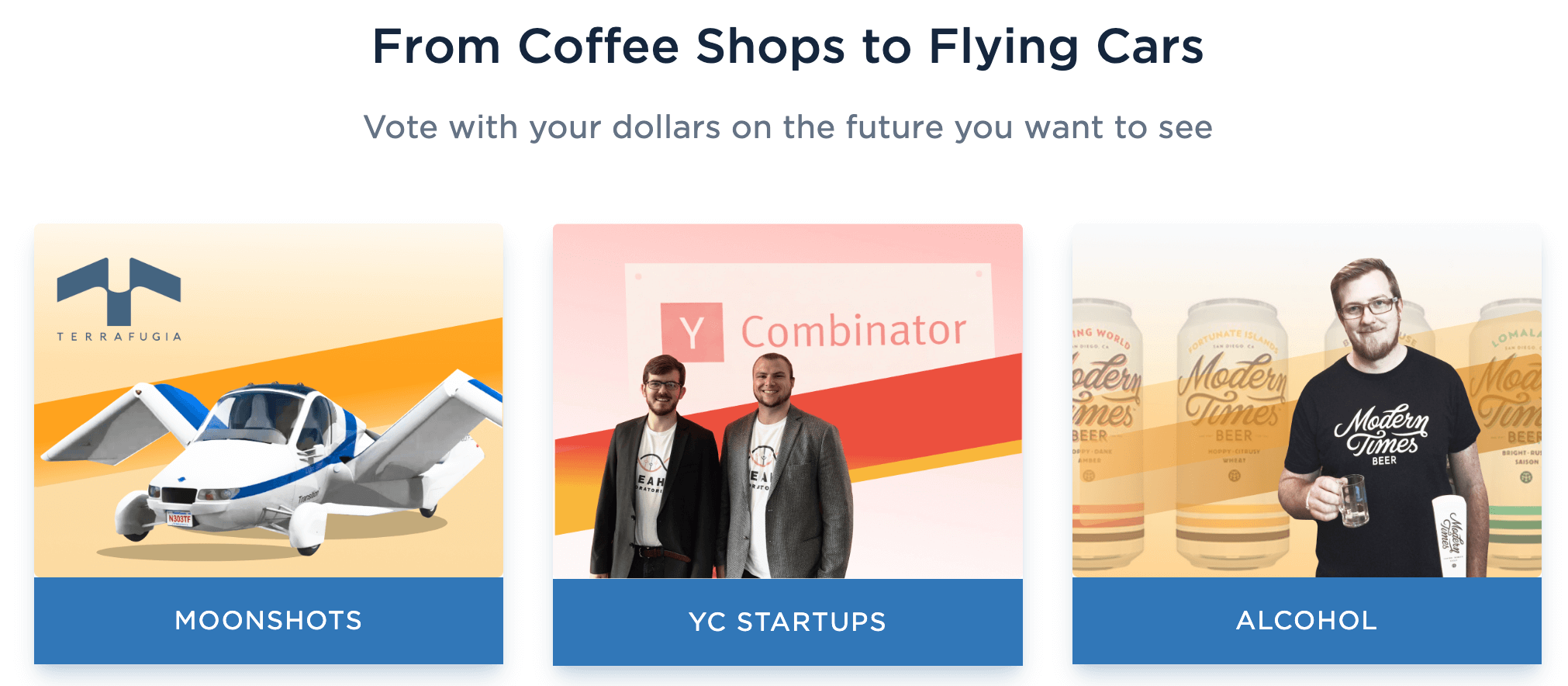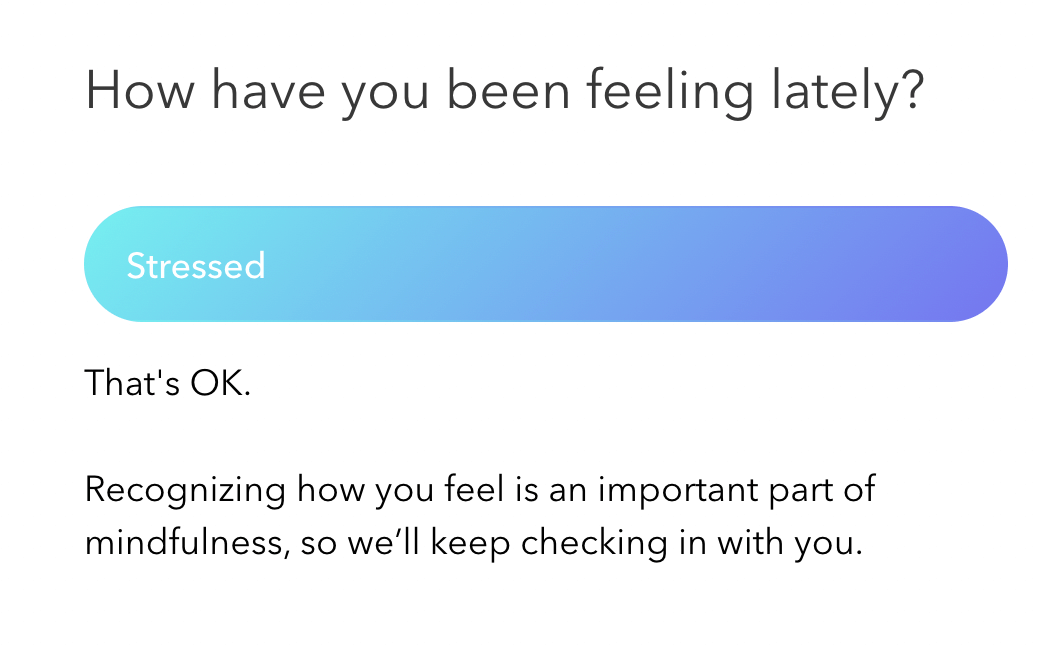I recently shared my experience with developing tone of voice (and how as a young copywriter, it used to scare the 💩 out of me!).
Part of what built up my confidence was working on different clients — with different tones of voice — but if you can’t get hands-on experience, analyzing different tones can be a helpful way to learn.
Side note: Analysis can be a really effective way to learn anything, whether it’s studying home decor or episodes of TV.
In today’s article, I analyze 5 different brands with very different tones and highlight some of the tactics they’re using to create their unique styles.
Hopefully this will remove some of the mystery around tone of voice, and show you how to properly execute your brand style within your messages.
Let’s dive in!
Tone example #1: Conversational, charming, authentic, engaging
Pick any product on the Food52 website and you’ll feel like you’re gabbing with your BFF who knows all things food, wine, and home.
But not in an annoying, know-it-all kind of way.

The Food52 brand does this by balancing their knowledge and authority with conversational elements like:
Natural language
Like “it’s so darn pretty” and “cheesy-pasta bits” and “check, check, check.”
Using words and phrases that your customer would naturally use (or relate to in some way) promotes authenticity and liking while making visitors’ brains perk up a bit.
Parentheticals that allow for more color and personality
Like “(especially in that new plum shade) and “(a la mode not optional)”
This sort of “stream of consciousness” approach adds more realism to the text, like it was written by a real person with real thoughts and emotions (vs something that feels generic or robotic).
Storytelling and future pacing
Like calling out specific use cases (“bubbly gratin, luscious lasagna, one-pan dinners”) that contain visual and appetite-wetting words.
Or by addressing potential concerns through story, like they did with this sentence: “And when the last bite leaves the table, a quick scrub with hot, soapy water will wash away even the most stubborn cheesy-pasta bits.”
By combining these various techniques, the brand creates a tone that feels authoritative and trustworthy while also feeling conversational and charming (no easy feat).
Tone example #2: Poetic, romantic, sensual, stimulating, visual
Unlike many e-comm products, fragrance can be a tougher sell, as it’s an aromatic that cannot be truly experienced through a computer screen.
To overcome this hurdle, the fragrance company Le Labo uses a variety of copywriting techniques that not only describe the product in a compelling way, but also communicate their unique tone of voice.

They do this by:
Painting the picture
Le Labo’s product descriptions feel less like “selling” and more like a story where the visitor is the protagonist.
Phrases like “imagine sitting in solitude,” “the wide plains of the American West,” “there is nothing around,” “an open fire,” and “the soft drift of smoke” – these help stimulate the visitors’ imagination while bringing the visual elements of the tone of voice to life.
Tactile words
Along with storytelling, Le Labo also uses tactile words – like “rugged,” “soft,” “crackle,” and “comforting” – to communicate a sense of touch and feeling (very important for something you can’t experience IRL).
Tactile words not only make the product feel more tangible, but also help create the sensuality and romanticism of the tone.
Evocation of the senses
Similar to tactile words, Le Labo uses words and phrases that evoke the senses of sight, touch, sound, and smell.
Phrases like “firelight on your face,” “soft, desert wind,” “cardamom and notes of iris and violet,” “smoking wood,” and “spicy, leathery, musky” all communicate aspects of the product, but in the poetic style of the brand.
Poetic elements
The brand uses poetic elements (like voice, diction, imagery, sound, etc) throughout the copy that hits on many of the components used in successful poetry.
For example, phrases like “You. Are. Free,” “the vast and wild universality of this dream,” “…that intoxicates…” and “where sensuality rises after the light has gone” – these act like unexpected notes in a song that keep us engaged and our emotions heightened.
The end result is a romantic and sensual tone of voice that feels more like it was written by a poet than a marketing person.
Tone example #3: Playful, fun, energetic, lively
In the past, the floral industry was a bit dull – it was either very corporate and transactional or stuffy and unapproachable.
But today, with so much competition, brands like Farmgirl Flowers have been able to carve out their own space within the industry, often leading with a unique style and tone of voice.

In the case of Farmgirl Flowers, they’ve opted for a sweet, playful, fun, and energetic style that extends into all of their copy, from product names and descriptions to sale codes and social media content.
They do this with:
Word play
There’s a reason it’s called “word play” – it’s fun and playful!
And Farmgirl Flowers does a great job of delivering on that promise with plenty of puns, metaphors, and cultural references to get visitors smiling (and hopefully buying).
For example, their product names like – “Aughty and Nice,” “Merry Styles,” and “Felt cute (Might delete later)” – make each product feel special while communicating that fun and playful style their brand is known for.
Humor
Similar to word play, Farmgirl Flowers also uses subtle humor to connect with visitors and make the shopping experience feel fun and lighthearted.
In the example below, they do this with the phrase “Waffling (and we’re not talking about breakfast)” as a way to disarm leads and showcase their relaxed, laid back style.
Relatable words & phrases
Like using “furry friends” instead of “pets” and “Mother Nature” instead of “the planet” – these are subtle ways of communicating a more playful and conversational style that may also resonate with their target audience.

Punctuation
While some may find their use of exclamation points excessive, they do effectively infuse a sense of energy into the copy that leaves you with a feeling of excitement and anticipation (never a bad thing when someone is shopping online!) ← oh boy, they’ve got me doing it now, too!
All of these elements combined create a fun, lively, and vivacious tone of voice that taps into the inner farm girl within us all.
Tone example #4: Clear, confident, forward-thinking, innovative
If you were to ask a bunch of SaaS companies to describe their ideal tone of voice, I bet many of them would say something like, “clear, confident, forward-thinking, and innovative.”
The problem is, so many SaaS companies get bogged down in the complexities of their products, they never quite “get there” when it comes to tone.
This is not the case for WeFunder, a SaaS company that has successfully executed their tone of voice in a way that is probably the envy of their competitors.

The funny thing is, there’s really nothing about their approach that isn’t replicable.
They do it by using:
Simple words and phrases
As soon as you read the hero copy on the WeFunder website, you know exactly what the product is and what kind of action you can take.
They do this by using common words that are simple (like “invest,” “little” and “businesses”) and phrases (like “invest as little as $100” and “businesses you believe in”) that are easy to understand.
There is also no jargon, which makes the product feel accessible to different types of people (vs just professional investors).
Simplicity in tone and style is also a way to remove complexity while also communicating a feeling of ease of use.
Clear & concise statements
While WeFunder could go into far more detail (like many of their competitors do), they opt for clear and concise statements that tell you just enough to pique your interest, like the example below:

Using clear and concise statements (vs overly verbose paragraphs) clarifies their ideas while communicating a sense of confidence.
Words & phrases that feel innovative
Like “future,” “flying cars,” “a new kind of stock market” and “we’re here to fix capitalism”
These kinds of words and phrases leave you with a forward-thinking, “challenger” type of tone that is likely to resonate with their unconventional target audience (nontraditional investors).
Altogether, the WeFunder tone of voice comes across as clear, confident, and even a touch rebellious, which is helpful when you’re asking people to join something that feels like a movement.
Tone example #5: Warm, gentle, caring, soothing, kind, empowering
Whether you’re reading the copy on the Calm website or engaging with their interactive sign-up flow, you’ll notice their tone of voice feels something like a therapist.
It’s warm, gentle, caring, soothing, and kind.

To create that specific style and tone of voice, Calm does things like:
Asking questions
Just like a therapist, the Calm sign-up flow asks you questions like “What can we help you with today?”, “How are you feeling lately?”, and “What’s typically the biggest source of stress for you?”
Asking simple but personal questions helps build trust with leads while also communicating the caring and empathetic tone of the brand.
Showing genuine care
Phrases like “we’ll keep checking in with you,” “showing up for ourselves and others” and “spend time in nature” make leads feel cared for and embody a feeling of warmth that can be difficult to experience through digital products.

Language that signals acceptance
Like “That’s OK” and “recognizing how you feel” are phrases that communicate self acceptance and a gentle kindness we as humans often forget to extend to ourselves.
This kind of language can feel soothing, especially for someone who is suffering and in need of healing.
Using empowering words
Like “nourishing,” “meaningful” “intentionally,” “cultivate” and “clarity” – these are words you might see in a self-help book as they can feel empowering.
These words balance out the softer side of the Calm brand voice by giving their target audience a sense of hope, power, and control over their healing process.
Overall, the tone of voice leaves visitors feeling heard and cared for, while giving them the support they need to make positive changes in their lives.
What are your tips for “nailing” tone of voice?
I’ll be the first one to say it: tone of voice is not easy.
But hopefully these examples show you that tone of voice is not something you pull out of thin air – you can use specific tactics and vocabulary to ensure each word reinforces the qualities of your brand.
If you’re trying to learn (or improve) your tone of voice skills, I encourage you to try the approach I used in this article.
Simply pick some of your favorite (or even obscure) brands, read through their copy, and see if you can summarize their style — and the tactics they’re using to create it.
Do you have any tips for getting tone of voice right? Share them below – I’d love to hear from you!
As always, thank you for reading – if you found this article helpful, please share it with a friend or colleague.
P.S. I’ll be doing another one of these articles soon with more examples and analysis, so stay tuned!
